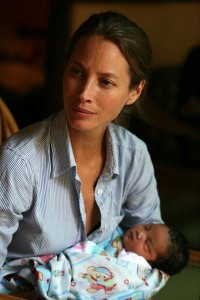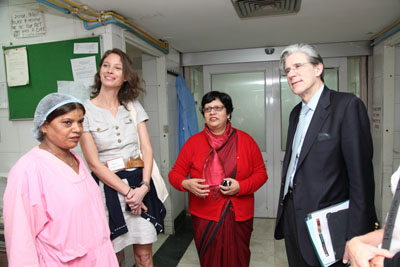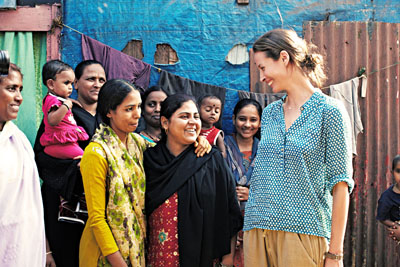By Anjum Choudhry Nayyar
 Health advocate and model Christy Turlington Burns became a global maternal health advocate when she became a mom eight years ago. When she gave birth to her first child, she experienced a complication that claims the lives of hundreds of thousands of women who do not have access to the care she received that day.
Health advocate and model Christy Turlington Burns became a global maternal health advocate when she became a mom eight years ago. When she gave birth to her first child, she experienced a complication that claims the lives of hundreds of thousands of women who do not have access to the care she received that day.
Once she learned about the global statistics related to maternal deaths, she felt compelled to use her voice and resources to do all she could to prevent these senseless deaths.
She launched Every Mother Counts, a campaign designed to increase education and support for maternal mortality reduction globally. She visited India in March of this year with the Dean of the Harvard School of Public Health to gain some perspective of India’s maternal health. India is one of the ten countries with the highest burden of maternal deaths in the world. Combined with Nigeria, these two countries make up one-third of the world’s total maternal deaths each year. In 1980, the maternal mortality ratio was 677 deaths out of 100,000 live births. The latest estimates have those rates dropping down to 200 deaths per 100,000 live births.
We had the chance to interview Christy about her work with Every Mother Counts and what she discovered.
What are some of the biggest health issues for mothers in India?
The ever-growing population in India is a huge factor. And extreme poverty is another. The two together create considerable health challenges. One of the most glaring problems for Indian mothers is how young so many of them are. The leading cause of death for girls ages 15-19 around the world is pregnancy or childbirth. If we can prevent child marriage and delay first pregnancy until a girl has matured, we could significantly reduce maternal deaths in many parts of the world. Comprehensive family planning is the preventative option we have, yet two few women have access to modern methods of contraception. If these needs were met globally, one third of maternal deaths could be prevented, and if women were able to space their births by 36 months, three million deaths of children under age five could prevented.

Photo Credit: Kuku Photography
What does your organization do to bridge some of the gaps in maternal health in India?
As an advocacy and mobilization organization, our job is to raise awareness as well as to support initiatives that reduce global maternal mortality. We also seek to educate the public about the problems and solutions and invite participation. This is a solvable yet tragic issue because so many of these deaths are preventable. By doing all of the above, we believe that many gaps can close.
During my travels with the Harvard School of Public Health, I learned of some successful efforts to bring maternal mortality rates down which I have been sharing. One being ASHAS (Accredited Social Health Activists), an effort instituted by the Government of India’s Ministry of Health and Family Welfare as part of the National Rural Health Mission in 2005. They expect this program to achieve full implementation this year. Another effective tool that is beginning to have an impact in reducing maternal deaths is the Safe Childbirth Checklist developed for the World Health Organization. This tool was designed to assist health workers who support mothers and newborns through deliveries. We visited the AIIMS teaching Hospital in New Delhi and met nurses who are using this tool already.
 What were you most surprised by in India?
What were you most surprised by in India?
I have visited India several times but had not been back in the last ten years. It is incredible how quickly parts of India are changing. While this growth and opportunity is exciting, I am concerned about disparities and the growing gap between the wealthy and the poor.
What inspired you about mothers in India?
Mothers the world over always inspire me. They work so hard. I never complain about my self-inflicted workload ever having witnessed what women do without thought or choice.
 What are your thoughts on female infanticide and was that part of your dialog while in India?
What are your thoughts on female infanticide and was that part of your dialog while in India?
I have read a lot about female infanticide and it was certainly on my mind throughout the trip. Gender equity is another underlying factor contributing to maternal mortality. When our girls and women are not valued in society at birth, what chance do they have in the world? If we really want to prevent maternal deaths in India more needs to be done to protect girls. I did visit a teaching hospital in Delhi that posted throughout the maternity ward their strict policy against sharing the sex of the child.
A recent article from the Guardian: “Trash Bin Babies: India’s Female Infanticide Crisis”
Tell us about your recent campaign and what you HOPED to achieve?
With the help of CHI&Partners, Every Mother Counts developed the “No Mothers Day” campaign, to raise awareness about the hundreds of thousands of girls and women around the world who die each year from complications related to pregnancy or childbirth. We asked mothers to invite others to “disappear” on Mother’s Day in solidarity with at-risk moms-to-be around the world. Why Mother’s Day, some asked, the one day when people think about mothers the most? We wanted to highlight just how much a mother is missed when she is gone. The goal was to get people across the country talking about this issue and we did. The centerpiece of this campaign was a short film by my husband, filmmaker Ed Burns, that has so far been viewed by 1.7 million people. In total, 7,000 people took one of the actions for No Mothers Day, and more than 4,000 new people signed up to be part of the Every Mother Counts community. We wanted to get people talking about this issue and we succeeded. Now we hope to keep the dialogue going so that we can come together to stop these senseless deaths.
[vsw id=”x0w669fZBH8″ source=”youtube” width=”425″ height=”344″ autoplay=”no”] Link : “No Mothers Day”How did you come up with the idea?
We started working with New York based creative agency CHI&Partners a few months ago to brainstorm compelling ways to create a national dialogue about the alarming global maternal mortality statistics that so many people remain unaware of. Mother’s Day was an optimal moment to communicate to the public about this issue. As such, this holiday has been central for my advocacy efforts for the last few years. But there is so much going on at this time, so our challenge was to find a way to get people to stop for a moment, or a day as we are suggesting, to reflect on the role of mothers rather than going through the motions as so many of us do. We wanted to try a different approach to get the attention of other moms and those who love them this year.
What do you hope will happen when people see this campaign? What is your goal?
I hope that the film gets people to stop for a moment and take the information in. Nearly 287,000 women die every year from largely preventable causes related to pregnancy and childbirth. If this information is shocking, as it should be, I hope they will come to Everymothercounts.org to learn more and find a way to become a part of the solution. We know that No Mothers Day itself and the act of silence won’t save lives- but it will raise awareness so that more people WILL be willing to take actions that will save lives.
 You had a personal experience that lead you to make your documentary, “No Woman, No Cry,” about the global tragedy of maternal mortality, and then the film led you to found EMC. What is next?
You had a personal experience that lead you to make your documentary, “No Woman, No Cry,” about the global tragedy of maternal mortality, and then the film led you to found EMC. What is next?
I am very much committed to doing all that I can to reduce maternal deaths and improve maternal health around the world. I will continue to use the film and EMC as a platform for my advocacy until the global figures are substantially reduced.
How can we help ensure our daughters have the tools to make a difference when it comes to equality?
I have a daughter and a son and believe that both sexes need to be taught by example about gender equality. My husband and I share responsibilities evenly. We both work but we take turns and trade off quite a lot so that we are able to also be there for our kids. I hope that they will benefit from knowing that gender balance is more than a possibility in their lifetime.



[…] South Asian community like Monika Deol, Lisa Ray, Mallika Chopra, Sangita Patel and also moms like Christy Turlington who brings awareness about barriers in maternal […]